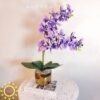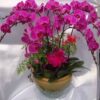# Phalaenopsis Orchids and Their Fusion with Floral Arrangement Art

Phalaenopsis orchids, commonly known as Lan Hồ Điệp, are among the most admired and popular orchids globally, prized for their exquisite beauty and long-lasting blooms. Their delicate, broad petals and graceful shapes have made them a favorite in the realm of floral arrangements and decorative art. This article delves into the fascinating intersection of Phalaenopsis orchids and the art of flower arrangement, exploring their significance, techniques, and the creative possibilities they offer.
## 1. The Allure of Phalaenopsis Orchids
### 1.1 Characteristics of Phalaenopsis Orchids
Phalaenopsis orchids are native to Southeast Asia, where they thrive in the warm, humid climates of countries like Indonesia, the Philippines, and Malaysia. These orchids are characterized by their:
– **Stunning Blooms**: Phalaenopsis orchids have large, flat flowers that come in a variety of colors, including white, pink, purple, yellow, and even spotted or striped varieties.
– **Long-lasting Flowers**: Their blooms can last several weeks to months, making them ideal for both indoor decoration and special occasions.
– **Ease of Care**: Compared to other orchid varieties, Phalaenopsis orchids are relatively easy to care for, which contributes to their popularity among novice and experienced gardeners alike.
### 1.2 Symbolism of Phalaenopsis Orchids
In various cultures, orchids are associated with beauty, luxury, and strength. Specifically, Phalaenopsis orchids symbolize:
– **Love and Fertility**: Their elegant appearance makes them a symbol of love and beauty, often gifted on romantic occasions.
– **Strength and Resilience**: The ability of these orchids to thrive in diverse conditions symbolizes strength and resilience.
– **Elegance and Sophistication**: Their exotic beauty embodies sophistication, making them a favorite in high-end floral arrangements.
## 2. The Art of Floral Arrangement
### 2.1 Understanding Floral Arrangement
Floral arrangement is an art form that involves creating visually appealing designs using flowers, foliage, and other natural materials. It can range from simple bouquets to intricate installations and serves various purposes, including:
– **Decorative Art**: Floral arrangements enhance the aesthetic appeal of spaces, from homes to event venues.
– **Symbolic Gifts**: Flowers convey emotions and messages, making them popular for gifts on special occasions such as weddings, anniversaries, and birthdays.
– **Cultural Significance**: Many cultures incorporate floral arrangements into rituals and celebrations, signifying beauty and life.
### 2.2 Elements of Floral Arrangement
Successful floral arrangements combine several key elements, including:
– **Balance**: A well-balanced arrangement distributes visual weight evenly, creating harmony.
– **Contrast**: Using contrasting colors, shapes, and textures adds interest and depth to an arrangement.
– **Proportion**: The size of flowers and the arrangement itself should be proportionate to the container and space.
– **Focal Point**: A focal point draws the viewer’s eye, often achieved by using larger or more colorful flowers.
## 3. The Perfect Match: Phalaenopsis Orchids in Floral Arrangements
### 3.1 Versatility of Phalaenopsis Orchids
Phalaenopsis orchids are incredibly versatile and can be used in various floral arrangements, including:
– **Bouquets**: Their elegant shape and vibrant colors make them perfect for bridal bouquets and other floral gifts.
– **Centerpieces**: Phalaenopsis orchids can be the centerpiece of tables at events such as weddings, banquets, and corporate gatherings.
– **Floral Installations**: These orchids can be used in larger installations, such as hanging arrangements or wall-mounted displays, creating stunning visual effects.
### 3.2 Techniques for Arranging Phalaenopsis Orchids
When incorporating Phalaenopsis orchids into floral arrangements, several techniques can enhance their beauty and impact:
#### 3.2.1 Color Coordination
Selecting complementary colors is crucial when arranging Phalaenopsis orchids. Consider the following:
– **Monochromatic Schemes**: Using different shades of the same color creates a sophisticated look.
– **Analogous Colors**: Pairing colors that are next to each other on the color wheel (e.g., purple and blue) can create a harmonious effect.
– **Contrasting Colors**: Bold contrasts, such as purple orchids with bright yellow flowers, can create a vibrant and dynamic arrangement.
#### 3.2.2 Layering Textures
Combining different textures can add depth to floral arrangements. Consider incorporating:
– **Foliage**: Use leaves from other plants to create a lush background for the orchids.
– **Fillers**: Incorporate smaller flowers or dried materials to fill gaps and create visual interest.
– **Natural Elements**: Adding stones, wood, or moss can enhance the arrangement’s organic feel.
#### 3.2.3 Height Variation
Varying the height of the flowers within an arrangement adds dimension and visual appeal. Techniques include:
– **Staggering Heights**: Arrange orchids at different heights to create an eye-catching display.
– **Using Vases of Different Heights**: Tall vases can hold longer stems, while shorter vases can accommodate more compact arrangements.
### 3.3 Tips for Caring for Phalaenopsis Orchids in Arrangements
To ensure that Phalaenopsis orchids remain vibrant and healthy in floral arrangements, consider the following care tips:
– **Watering**: Ensure that the stems are submerged in water and replace it regularly to maintain freshness.
– **Light**: Place arrangements in a location with indirect sunlight to prevent the flowers from wilting.
– **Temperature**: Keep arrangements away from drafts, heat sources, and cold air to prolong the life of the orchids.
## 4. Creating Stunning Floral Arrangements with Phalaenopsis Orchids
### 4.1 Step-by-Step Guide to Arranging Phalaenopsis Orchids
Creating a floral arrangement with Phalaenopsis orchids involves several steps:
#### Step 1: Gather Materials
You will need:
– Fresh Phalaenopsis orchids
– Additional flowers (e.g., roses, lilies) for contrast
– Foliage (e.g., ferns, eucalyptus)
– A vase or container
– Floral foam (if needed)
– Scissors and floral tape
#### Step 2: Prepare the Container
– If using floral foam, soak it in water before placing it in the container. This will help keep the flowers hydrated.
– Choose a container that complements the style of the arrangement (e.g., glass for a modern look, ceramic for a rustic feel).
#### Step 3: Arrange the Foliage
– Start by adding foliage as a base to create structure. This can help frame the orchids and provide a lush background.
#### Step 4: Position the Phalaenopsis Orchids
– Insert the Phalaenopsis orchids at varying heights, ensuring they are evenly spaced for balance.
– Make sure the flowers are positioned to face outward for maximum visual impact.
#### Step 5: Add Additional Flowers
– Fill in any gaps with additional flowers, using complementary colors and textures to enhance the arrangement.
#### Step 6: Final Touches
– Adjust the positioning of the flowers to achieve balance and harmony.
– Add water to the container and ensure all stems are submerged.
– Trim any excess foliage that may clutter the arrangement.
### 4.2 Seasonal Arrangements with Phalaenopsis Orchids
Phalaenopsis orchids can be incorporated into seasonal arrangements, celebrating various holidays and occasions:
– **Spring Arrangements**: Pair orchids with pastel-colored flowers like tulips and daisies for a fresh, spring-inspired look.
– **Summer Displays**: Combine vibrant orchids with tropical flowers such as hibiscus or birds of paradise for a lively summer arrangement.
– **Autumn Centerpieces**: Use warm-toned orchids alongside sunflowers and autumn foliage to create a cozy fall centerpiece.
– **Winter Decor**: Incorporate Phalaenopsis orchids with evergreen branches and pine cones for a festive holiday arrangement.
## 5. Phalaenopsis Orchids in Cultural and Ceremonial Contexts
### 5.1 Traditional Vietnamese Culture
In Vietnamese culture, flowers hold significant meanings, and orchids, especially Phalaenopsis, symbolize elegance, beauty, and refinement. They are often used in:
– **Tet Festival**: During the Lunar New Year, families display orchids to symbolize prosperity and good fortune.
– **Weddings**: Phalaenopsis orchids are frequently included in bridal bouquets and decorations, representing love and happiness.
### 5.2 Western Floral Traditions
In Western cultures, orchids are associated with luxury and sophistication, making them a popular choice for:
– **Corporate Events**: Phalaenopsis orchids are often used in arrangements for corporate events, symbolizing professionalism and success.
– **Funerals**: White orchids are commonly used in funeral arrangements, signifying beauty and the fleeting nature of life.
## 6. Conclusion
Phalaenopsis orchids and the art of floral arrangement come together to create stunning displays that enhance any environment. Their versatility, elegance, and rich cultural significance make them a perfect choice for both casual and formal occasions. By understanding the characteristics of Phalaenopsis orchids and the principles of floral design, anyone can create beautiful arrangements that celebrate the beauty of nature.
As the popularity of Phalaenopsis orchids continues to grow, so does the creativity surrounding their use in floral arrangements. From weddings to corporate events and home decor, these orchids are sure to leave a lasting impression, showcasing their timeless beauty and charm. Whether you are an experienced florist or a novice gardener, embracing the art of floral arrangement with Phalaenopsis orchids opens up a world of possibilities for artistic expression and aesthetic enjoyment.

